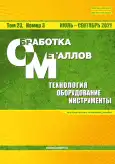Введение. Статья посвящена вопросу создания экологически безопасной, технологически эффективной и экономически выгодной высокопроизводительной комплексной схемы по переработке свинецсодержащих промпродуктов и отходов, в частности висмутистых окислов и дроссов, образующихся при плавке медеэлектролитного шлама, с получением товарных моноэлементных продуктов. Для решения задачи используется комбинированная технология, основу которой составляют гидрометаллургические операции, позволяющие разделять близкие по свойствам химические элементы с высоким извлечением их в готовую продукцию. Целью работы являлось исследование и разработка принципиальных подходов и рациональных комплексных технологий переработки висмутистых дроссов и окислов ? промпродуктов рафинирования свинца чернового, с использованием восстановительных плавок сырья и обогащенного висмутом шлама, электролизом висмутистого свинца с получением висмута чернового, содержащего ≥ 90 % Bi при его прямом извлечении ≥ 70 %. Методы. Проплавление при температуре 1100…1150 оС шихты оптимального состава, содержащей висмутистые окислы, карбонат натрия, диоксид кремния и углерод. Новизной выполненных исследований является снижение содержания благородных металлов и сопутствующих им халькогенов во вторичном медьсодержащем сырье при увеличении количества элементов-примесей. Результаты и обсуждение. Совместная плавка (1100…1150 ºС) висмутистых окислов, карбоната натрия, диоксида кремния и углерода, взятых в массовом соотношении 100 : (15…66) : (11…25) : (5…7), позволяет перевести 89,0…93,6 % висмута и 99,5…99,7 % свинца из исходных окислов в висмутистый свинец, содержащий ~7 % Bi и ~80 % Pb. Основной фазой Pb-Bi сплава является элементный свинец. Повышенный расход флюсов ведет к росту количества бедных по целевым металлам оборотных силикатных шлаков, в которые переходит, %: 1,4 Bi; 2 Pb; 47 Zn; 23 Sb; 33 Sn. Основные фазы шлака: Na2CaSiO4, Na4Mg2Si3O10, MgO, Pb, ZnS, PbS. Практическая значимость определяется оптимальным режимом восстановительной плавки висмутистых окислов (100 %) с получением висмутистого свинца, %: 66 Na2CO3, 25 SiO2, 5 С; температура процесса – 1150 ºС. Наличие примесей обусловливает необходимость введения в технологическую схему переработки висмутистых окислов операций реагентной обработки висмутистого свинца. Обезмеживание и щелочное смягчение позволят получить Pb-Bi-сплав, пригодный для переработки пироэлектрометаллургическим способом.
 6-19
6-19


 20-30
20-30


 31-44
31-44


 45-71
45-71


 72-83
72-83


 84-99
84-99


 100-111
100-111


 112-123
112-123


 124-138
124-138


 139-154
139-154


 155-165
155-165








